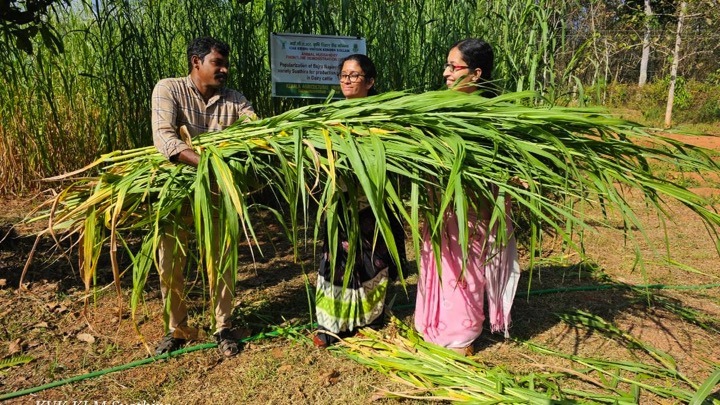The hybrid napier grass developed by Kerala Agricultural University is climate resilient and requires minimum maintenance; fat percentage in milk of cross-bred jersey cows fed with the grass increased to 6.
While Kerala has been facing a scarcity of fodder grass, Susthira, a hybrid napier grass, is gaining popularity among dairy farmers in Kollam.
Developed by Kerala Agricultural University, the grass is climate resilient and requires minimum maintenance, making it an ideal option for many, especially when cattle feed prices are spiralling. After the on-farm trials carried out by the Krishi Vigyan Kendra (KVK) proved successful, around 50 farmers in the district have started cultivating the variety.
“I didn’t water the crop for one month after planting, but there was no dip in yield or feed palatability. It’s a hassle-free process. You can reduce the amount of cattle feed by half,” says S. Sujeesh, a dairy farmer from Pattazhy.
Increase in production
The first animal husbandry trials in the State were carried out by the KVK, Kollam, where cross-bred jersey cows were fed the grass for a month. “As per the readings, there was an average increase of 1.5 litres of milk a day. While the normal fat percentage in cross-bred jerseys varies between 3.5 and 4.2, it crossed 6 in cows that were given Susthira. Trials were carried out in both summer and southwest monsoon seasons and the results are district specific,” says S. Parvathy, Assistant Professor (Animal Husbandry), KVK.
An adult cow requires around 30 kg of green fodder a day, which is an impossible task during summer months. In order to ensure maximum productivity, cows are often fed extra concentrate by the farmers. “If we have enough quality green fodder, we can bring down the quantity of concentrate, but we have to standardise the per cent,” she adds.
Farmers usually depend on a couple of known varieties such as Co1 and Co2 for green fodder, but the results of farm trials show that Susthira is a much better option. Another highlight of the crop is its heat resilience as thermal stress will not affect its growth to a great extent. “While other grass varieties will wilt without moisture, Susthira can survive without regular watering or rain,” says C.R. Neeraja, assistant professor (Agronomy), KVK.
Around 100 grass slips can be planted on 1% of land and the crop will be ready for harvest within 75 days. After the first harvest, the farmers can cut the grass every 45 days and the production potential of a hectare of land is around 300 tonnes per annum. Cow dung slurry, which is easily available at dairy farms, is used as manure for succulent regrowth after each harvest.
“Apart from the grass, the farmers can also sell Susthira slips. Just 2.5 cents of land will be sufficient to generate green fodder for two cows,” says Ms. Neeraja.



























